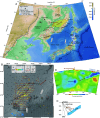The return of stagnant slab recorded by intraplate volcanism
- PMID: 39793068
- PMCID: PMC11725906
- DOI: 10.1073/pnas.2414632122
The return of stagnant slab recorded by intraplate volcanism
Abstract
Subducted plates often stagnate in the mantle transition zone (MTZ), and the fate of the stagnant slabs is still debatable. They may sink into the lower mantle, or remain partially trapped in the MTZ, but it is uncertain whether they can return to the upper mantle. We report geochemical evidence of late-Miocene (~6 Ma) basalts from, and upper mantle seismic evidence beneath Shuangyashan, an area above the slab tear of the stagnant Pacific plate in eastern Asia, to show how the slab returns to the upper mantle from the MTZ. Remarkably high δ57Fe, Gd/Yb and low δ26Mg, Ti/Eu, CaO/Al2O3 values of Shuangyashan basalts suggest that the subducted Pacific oceanic crust had been entrained to their upper mantle source. Therefore, the return of oceanic crust from the MTZ to the upper mantle appears to have been driven by upwelling triggered by tearing of the stagnant slab right beneath this area. Meanwhile, local shear splitting measurements reveal a circular pattern of anisotropy in the upper mantle with delay times diminishing toward the slab tear, suggesting that the slab-fragment-bearing upwelling subsequently turned into lateral flows in the upper mantle, and contributed to a wider intraplate magmatism above the stagnant slab. This finding, together with other widespread intraplate volcanism from eastern Asia, extending for approximately 6,000 km, demonstrates that a subduction-induced tear can lead to the destruction and partial return of stagnant slab material, and thus lead to the cycling of subducted crustal materials and the generation of subduction-induced intraplate magmatism.
Keywords: intraplate basalts; mantle transition zone; mantle upwelling; slab tear; stagnant slab.
Conflict of interest statement
Competing interests statement:The authors declare no competing interest.
Figures





References
-
- Richards M. A., Engebretson D. C., Large-scale mantle convection and the history of subduction. Nature 355, 437–440 (1992).
-
- Hofmann A. W., Mantle geochemistry: the message from oceanic volcanism. Nature 385, 219–229 (1997).
-
- Faccenna C., et al. , Subduction-triggered magmatic pulses: A new class of plumes?. Earth Planet. Sci. Lett. 299, 54–68 (2010).
-
- Marquardt H., Miyagi L., Slab stagnation in the shallow lower mantle linked to an increase in mantle viscosity. Nat. Geosci. 8, 311–314 (2015).
-
- Ishii T., et al. , Buoyancy of slabs and plumes enhanced by curved post-garnet phase boundary. Nat. Geosci. 16, 828–832 (2023).
Grants and funding
LinkOut - more resources
Full Text Sources

